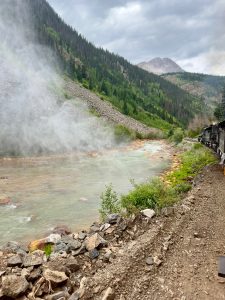All Aboard the Durango-Silver Train!
Everybody loves the sound of a train in the distance.
— Paul Simon
ABOARD THE DURANGO-SILVERTON NARROW GAUGE RAILROAD — In 1881, this railroad began operating between Durango and Silverton, Colorado — two towns willed into existence by railroad magnates to transport tourists, gold and silver. The gold and silver played out long ago, but the tourist trade remains healthy. My Beautiful Mystery Companion and I are attempting to escape the Texas heat with a road trip out west, eventually landing in Pagosa Springs, an hour west of Durango. We bought a pair of tickets on the steam train to enjoy a leisurely, 20 mph, all-day excursion up the San Juan mountains from Durango to Silverton, and back.
The train slowly chugs out of the station in downtown Durango and makes its way out of town, passing along homes built along the tracks. Nearly everyone that sees the train stops to wave, and we wave back. People out jogging on park trails or stuck in their vehicles waiting for the train to pass or mowing their backyards — the train earns a smile and wave. We wave back, of course. Kids lean out of car windows and pump their arms up and down, imitating the engineer blowing the steam whistle, which is done with regularity. A steam train’s whistle can rattle windows. Everybody might love the sound of a train in the distance, but living next to the track could be annoying.
On our entire trip — through West Texas, to Taos, and then to eastern Colorado — we have been hoping to see elk. On our last two trips west, we never saw one of these magnificent creatures. Maybe this will be the lucky occasion. So, each time we see an “Elk Crossing” sign, we are on full alert, to no avail. Finally, on this train trip our wishes are granted. A pair of elk are grazing peacefully in a subdivision by the tracks, right there in town, without an “Elk Crossing” sign in sight. A wayward tee shot from the nearby golf course could have winged them.
The Animas River flows nearby for just about the entire trip, its emerald-green water rushing over rocks. Occasionally we see someone casting a line into the water. Invariably they wave as well. At times the river is 400 feet below the tracks, at others nearly level with us. We take turns leaning cautiously out the window to take photographs, keeping a tight grip on our phones. The conductor has told us the train would stop if someone did drop a phone, but I do not want to be that guy. I have already been responsible for a commercial airliner having to make an emergency stop to let me off. But that is another story.
We arrive in Silverton under cloudy skies, 65 degrees and light rain. With August knocking on the door, we revel in the cool weather, however temporary it may be. Silverton’s sole reason for existing today appears to be for tourism. At 9,318 feet altitude and located in a remote part of the San Juan Mountains, the town is on occasion snowbound in the winter. Summertime appears to be a peak time for tourists, either arriving on the train or driving up Hwy. 550. The storefronts look as if they could serve as a movie set in a Western movie. I half expect a gunfight to break out on its wide streets at any moment.
After a pleasant lunch and a bit of souvenir shopping, we get back on the train for the three-and-a-half-hour trip back down the mountain, sitting this time in an open-air car with a curved plexiglass roof. The weather has warmed up considerably after the skies cleared. The rumble of the train clickety-clacking along the tracks along with the rhythmic hissing of its engine makes us both sleepy. The steam whistle serves to wake us up.
It is difficult to fathom the blood, sweat and tears that went into building 45 miles of track more than 140 years ago to link these two towns, Durango and Silverton. The steam train still chugs up and down the mountain, the only evidence of its original purpose a long-abandoned mine just south of Silverton.
I can still hear that steam whistle blowing in my mind, the chug of the engine recalling that famed children’s book: The Little Train That Could, with its chant of, “I think I can. I think I can.”
Indeed, it could.
Leave a reply
Fields marked with * are required












